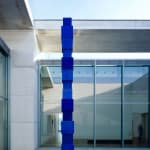Jürgen Partenheimer
Weltachse, 1998
Bronze sculpture (13 parts)
710 x 65 x 65 cm
279 1/2 x 25 5/8 x 25 5/8 inches
279 1/2 x 25 5/8 x 25 5/8 inches
Ed. 6/6
Copyright The Artist
Photo: Reni Hansen, Jürgen Partenheimer, Benedikt Partenheimer, Christian Kain
Weitere Abbildungen
Die Farbigkeit der Skulptur Axis Mundi / Weltachse (1994-2018) wird geprägt durch ultramarines Blau in drei Farbwerten. Die aufgetürmten Kuben der verschiedensten Variationen und Modelle der Weltachse haben dabei keine...
Die Farbigkeit der Skulptur Axis Mundi / Weltachse (1994-2018) wird geprägt durch ultramarines Blau in drei Farbwerten. Die aufgetürmten Kuben der verschiedensten Variationen und Modelle der Weltachse haben dabei keine vernünftige Höhe im üblichen Sinne. Ihre Ähnlichkeit untereinander bewirkt eine dynamisch aufsteigende Energie entlang der Kantenlinie der Skulptur. Die Selbstähnlichkeit der Kuben zeigt im Ausschnitt Merkmale des Ganzen und führt zu einer komplexen Struktur, die unbestimmbar und jederzeit veränderbar bleibt. Das System der Aufstellung der Skulptur ist berechenbar, aber sensitiv, jede Veränderung der Anfangsposition ergibt einen neuen Rhythmus. Mit der Höhe der Skulptur und mit dem exakt definierten Aufstellungsort reagiert Partenheimer sensibel auf die jeweilige Umgebung zwischen Architektur und Natur.
Nachdem Jürgen Partenheimer bereits 1983 ein Modell aus Sperrholz gebaut hatte, wurde wurde die erste Weltachse 1993 für eine Installation im Gemeentemuseum in Den Haag realisiert. Der Künstler setzte eine Säule aus handgefertigten Holzkuben zusammen, die er mit aquarelliertem Reispapier überzog. 1997 folgte eine erste Version für den Außenraum in Bronze für das Stedelijk Museum in Amsterdam. Hinzu kamen weitere - teils temporäre - Standorte in den Niederlanden, Deutschland, Italien, Spanien, China und England. Anlässlich der Ausstellung „Das Archiv" war die Weltachse 2014 in der Rotunde der Pinakothek der Moderne ausgestellt.
The color of the bronze cubes of Axis Mundi (1994-2018) is predominately ultramarine blue, divided in three translucent chromatic shades. The system according to which the cubes are stacked implies no rational or logic height. Their mutual similarity emphasises a dynamic, upward thrusting energy on all sides of the sculpture. The self-similarity of the cubes shows characteristics of the whole in the detail and leads to a complex structure that remains indeterminable and changeable at any time. The system of placing the sculpture is calculable but sensitive, every change of the initial position results in a new rhythm. With the variable height of the sculpture and the precisely defined installation site, Partenheimer reacts sensitively to the respective environment between architecture and nature.
After Jürgen Partenheimer had already built a plywood model in 1983, the first Axis Mundi was realized in 1993 for an installation in the Gemeentemuseum in The Hague. The artist assembled a column from handmade wooden cubes, which he covered with watercolored rice paper. In 1997 a first version for the exterior in bronze for the Stedelijk Museum in Amsterdam followed. In addition, there were further - partly temporary - locations in the Netherlands, Germany, Italy, Spain, China and England. On the occasion of the exhibition "The Archive" the World Axis 2014 was exhibited in the rotunda of the Pinakothek der Moderne.
Nachdem Jürgen Partenheimer bereits 1983 ein Modell aus Sperrholz gebaut hatte, wurde wurde die erste Weltachse 1993 für eine Installation im Gemeentemuseum in Den Haag realisiert. Der Künstler setzte eine Säule aus handgefertigten Holzkuben zusammen, die er mit aquarelliertem Reispapier überzog. 1997 folgte eine erste Version für den Außenraum in Bronze für das Stedelijk Museum in Amsterdam. Hinzu kamen weitere - teils temporäre - Standorte in den Niederlanden, Deutschland, Italien, Spanien, China und England. Anlässlich der Ausstellung „Das Archiv" war die Weltachse 2014 in der Rotunde der Pinakothek der Moderne ausgestellt.
The color of the bronze cubes of Axis Mundi (1994-2018) is predominately ultramarine blue, divided in three translucent chromatic shades. The system according to which the cubes are stacked implies no rational or logic height. Their mutual similarity emphasises a dynamic, upward thrusting energy on all sides of the sculpture. The self-similarity of the cubes shows characteristics of the whole in the detail and leads to a complex structure that remains indeterminable and changeable at any time. The system of placing the sculpture is calculable but sensitive, every change of the initial position results in a new rhythm. With the variable height of the sculpture and the precisely defined installation site, Partenheimer reacts sensitively to the respective environment between architecture and nature.
After Jürgen Partenheimer had already built a plywood model in 1983, the first Axis Mundi was realized in 1993 for an installation in the Gemeentemuseum in The Hague. The artist assembled a column from handmade wooden cubes, which he covered with watercolored rice paper. In 1997 a first version for the exterior in bronze for the Stedelijk Museum in Amsterdam followed. In addition, there were further - partly temporary - locations in the Netherlands, Germany, Italy, Spain, China and England. On the occasion of the exhibition "The Archive" the World Axis 2014 was exhibited in the rotunda of the Pinakothek der Moderne.
exhibitions
1997 Stedelijk Museum Amsterdam, Vondel Park1998 Kunstmuseum Bonn
1998 IVAM, Valencia
2000 Forbidden City, Beijing
2014 Pinakothek der Moderne, Munich
2016 Sculpture in the City, London
Collections
Munich Re, Munich
Private Collection Norther Germany
Private Collection Stuttgart
Private Collection Northern Italy
Private Collection Cologne







